It’s Fourth of July weekend, and our pullets are now 14 weeks old.
While everyone is hitting the road travelling to their long-weekend destinations, in anticipation of festive summer barbeques and fireworks, the Independence Day festivities got us thinking about some ‘olde tyme’ fowl.
When the Declaration of Independence was signed, what breeds of poultry were common on the average American homestead in 1776?

None of the breeds currently at Curbstone Valley existed when the Declaration of Independence was adopted
The breeds we selected for the farm this year, although generally considered heritage breeds, are actually fairly recently developed breeds. The Plymouth Rocks were originally developed almost a century after the Declaration was written. Our Buff Orpingtons, Wyandottes, and Black Australorps weren’t developed until the late 19th to early 20th Century. The youngest of our breeds, the Delawares, were created by George Ellis in 1940! None of the breeds currently at Curbstone Valley even existed when Thomas Jefferson was busy drafting The Declaration.
Thomas Jefferson himself is known to have experimented with breeding and rearing poultry, including bantams, and a number of references exist regarding this endeavor, although specifics as to breeds aren’t clear.
Perhaps the most common fowl in Jefferson’s day was the Dunghill fowl, also known as the Barn-door fowl. This breed is occasionally seen listed in probate documents dating to the early-mid 18th Century, although technically it was produced from crosses of many common breeds of the day, which included the Dorking, and Dutch Hamburgs. The Dunghill was a mutt. It had no standard of appearance, and as a common barnyard mix, would occur in a wide array of colors. It was a small bird, and generally a poor layer, and was reported to be ‘the only fowl the poor man can obtain’, but it needed minimal care, so was cheap to buy, and virtually free to keep.
However, at the time The Declaration was written, the Dominique, also known in New England as the Pilgrim Fowl, from which the Plymouth Rock reportedly originated, was also becoming very popular. It was one of the first true poultry ‘breeds’ developed in North America from birds originally brought by the Colonists to New England, including the Dorking, Old English Fowl and Sussex. Dutch Hamburgs may also have contributed to the Dominique’s origin. In Frank Platt’s 1921 The American Breeds of Poultry he refers to the Dominique as ‘…nothing more or less than a hawk-colored dunghill bird, improved by cultivation’.
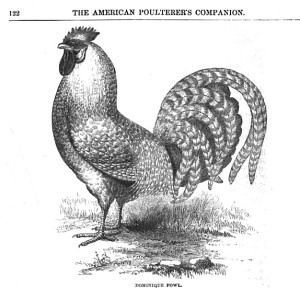
Illustration of a Dominique Rooster published in 1876, 100 years after the Declaration was signed (Public Domain Image)
Regardless of the Dominique’s murky origins, the Dominique was clearly displacing the Dunghill as the most popular chicken on the farmstead. Apparently even Abraham Lincoln owned Dominique fowl. Their popularity endured for more than a century, and in Miner’s Domestic Poultry in 1853 it is stated in regards to the Dominique ‘It will hardly be necessary to give a detailed description of this breed, so well known in almost every farm-yard in the country.‘
In 1871 these birds were so common, The American Poulterer’s Companion referred to Dominiques as ‘mere farm-yard fowl’, but many articles from the 19th Century support that this breed was very much a work-horse of the American farmstead. Dominiques were excellent all-purpose fowl, regarded highly for their feathers for stuffing pillows and mattresses, their good quality meat, and for being modest egg layers, with calm dispositions. However, as more fanciful breeds were imported from Europe, the Dominique fell out of favor, and within thirty years of being proclaimed ‘mere farm-yard fowl’, they were bordering on extinction at the turn of the 20th Century.
So although we know that Thomas Jefferson never saw a Golden Laced Wyandotte, it’s quite likely that he was at least familiar with the Dominique. If you’re interested in truly historic breeds of chicken, the Dominique, still on the American Livestock Breeds Conservancy watch-list, would be an excellent choice.
In the meantime, we return you to the festivities of the Fourth. We’ve decided to stay close to home this long weekend, so we can avoid the holiday traffic…
This way we can enjoy the gorgeous weekend weather, relax, and not have to worry about entertaining house guests…
Curbstone Valley Farm wishes everyone safe travels, and a happy holiday weekend!
“I know of no pursuit in which more real and important services can be rendered to any country than by improving its agriculture, its breed of useful animals, and other branches of a husbandman’s cares.” – George Washington


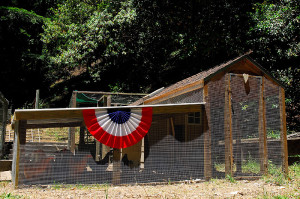

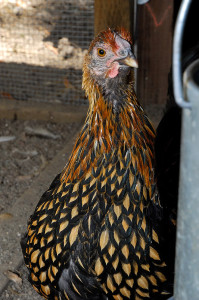
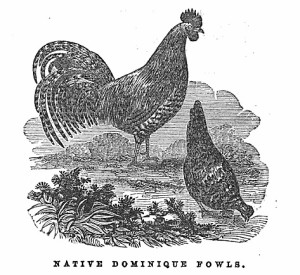
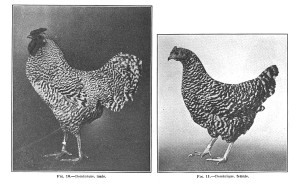







I have to admit, I don’t know much of the history of our breeds so this was a very interesting read. Happy 4th to you and your fowl!
What a great post! I have to admit, I’m a sucker for rare and unusual breeds. I’m currently searching for Sussex (not the Speckled Sussex, but the original Sussex) chicks and hope to also get Dorkings along with some other old/rare breeds.
I wonder what “hawk colored” means.
How’s Frodo?
‘Hawk colored’ was a term used to referred to the barring in the feathers seen in birds like the Dominiques, or Barred Rocks.
As for Frodo, he’s fine, but I think he has post coming up all of his own soon 😛
What a terrific post! Thanks & Happy Fourth!
I’m sure I saw Dominique’s at my Uncles Farm at Easter time. If they are the same breed they were my favourite roosters and poulets that day. They were very vocal.
Its attributes certainly made it a very favourable fowl to breed in those days. I suppose its modest egg laying was the reason people favoured newer breeds as they probably wanted a breed that could produce more eggs.
Have a lovely 4th of July weekend Clare
:Rosie
Definitely, egg and meat production ‘improvements’ have certainly affected breed popularity. However, last night we were going through old poultry journals, and the advertisements were spectacular. There definitely seemed to be a lot of interest not just in economical poultry production, where for $4 you could receive 100 hatching eggs, but showy poultry for exhibition and breeding too. Some ‘new breeds’ that were winning shows, like ringlet barred rocks, were quite expensive, up to $2 each in the 1880s!
What an awesome post! Laced with Revolutionary Era history…you’re my kind of chick! (no pun intended…ok, well, sorta)
You have a great deal of fowl knowledge! Beautiful fowl photos as well. Love that quote at the end. Happy 4th of July!
Clare, Thanks for the wonderful history lesson; this is so informative. Do you know Bailey White’s novel “Quite a Year for Plums?” One of the main characters is an artist who is obsessively painting Dominiques, and the chickens are the stars of the book’s dust jacket. Now that I have more context, I might just go back and re-read it. 🙂
I love your spin on the fourth of July… unique and so enjoyable!
Great history, Clare. I had no idea the heritage breeds were such recent developments in agriculture. I agree with George Washington’s quote above. He was a pretty smart guy, I guess. 😉
Happy Fourth!
A post as informative and entertaining as ever you produce – your posts are mini-essays you could publish as a book. Thanks for the time, effort and talent you pour into your blog.
I’m glad you still have your thumb…after feeding them. I loved watching them. They are all so different and unique. I bet they are fun to watch. Fun post!
I was surprised to hear that these chicken breeds haven’t been around for as long as I assumed. I mean, with a name like Plymouth Rock you would think they would have come over on the Mayflower!
It’s similar with vegetables and fruits, if you think about it. There might be an exception or two, but most of the heirloom varieties haven’t been around anywhere near 200+ years.
Your posts are always so interesting! One day if we ever have room to have chickens, etc I’ll feel like I already know a lot just from reading your blog. I love how you decorated their coop.
Fantastic post on your chickens and the different varieties “back in the day”! I really must say that you know your chicken facts! Impressive!! Your Golden Winged Wyandotte is a beautifully patterned bird – exquisite acually! And I really like the way your flock celebrates the 4th – very festive group. Happy belated 4th!!
You ‘scratched’ up some great info for all us chicken lovers to ponder. I’m a fan of Golden-Laced Wynandottes as well, and French Marans, too. (A General Lafayette, among them, no doubt.) Nice post, lovely site.